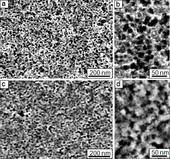Highlight
A General Route for the Synthesis of Nanocrystal-Based Mesoporous Films
Achievement/Results
With the support of the National Science Foundation IGERT program, Iris Rauda, a graduate student in the Department of Chemistry and Biochemistry, along with other members in the group of Professor Sarah Tolbert, have successfully developed a general method to assemble preformed nanocrystals into hierarchical mesoporous architectures. The ability to assemble preformed nanocrystals into ordered porous structures is highly desirable because the nanocrystals are already crystalline with a unique composition, size, and shape. It is well established that nanocrystals exhibit unique physical and chemical properties that are not always observed in their bulk counterparts. Preformed nanocrystals can serve as building blocks to construct high surface area materials for various applications depending on their functionality. In this work, we have successfully templated nanocrystals from a range of materials, including redox-active transition metal oxides (Mn3O4), conductive tin-doped indium oxide (ITO), and semiconducting CdSe nanocrystals.
In this method, nanocrystals synthesized with organic ligands are stripped of their ligands using various BF4—based salts to form “bare” nanocrystals that can be dispersed in polar coordinating solvents. In polar solvents, amphiphilic block copolymers form micelles that are mixed with the “bare” nanocrystals. Upon evaporation of the solvent, the nanocrystals coassemble with the polymer micelles into an ordered organic-inorganic mesostructured composite. Thermal degradation of the polymer template leaves behind a porous network of nanocrystals that exhibit a high surface area with bimodal porosity. The high surface area comes from a combination of the mesopores, created by the polymer template, and micropores, created by the spaces in between the nanocrystals embedded in the pore walls. We have demonstrated that all nanocrystals retain their crystal structure, nanodimensions, and shape after templating. In addition, the mesoporous ITO films demonstrate good conductivity, and the CdSe films maintain the strong absorption of quantum confined semicondutors.
Reference: Iris E. Rauda, Raffaella Buonsanti, Laura C. Saldarriaga-Lopez, Kanokraj Benjauthrit, Laura T. Schelhas, Morgan M. Stefik, Ulrich Wiesner, Delia J. Milliron, Sarah H. Tolbert, “ A general method for the synthesis of hierarchical nanocrystal-based mesoporous materials”, submitted to ACS Nano.
Iris E. Rauda, Laura C. Saldarriaga-Lopez, Delia J. Milliron, Brett Helms, Sarah H. Tolbert, “Assembly of Ligand-stripped CdSe Nanocrystals into Hierarchical Mesoporous Architectures”, manuscript in preparation.
Address Goals
This work demonstrates that nanocrystals of almost any type can be assembled into hierarchical mesoporous architectures. By carefully selecting the type of nanocrystal and block copolymer template, the ability to precisely define the final architecture is realized.






